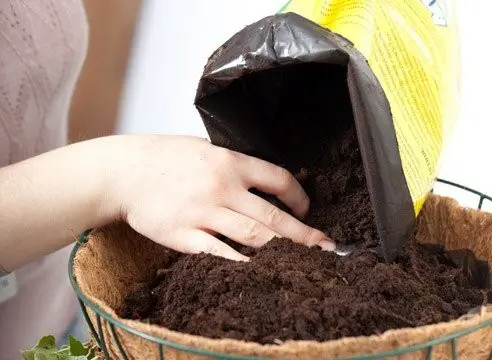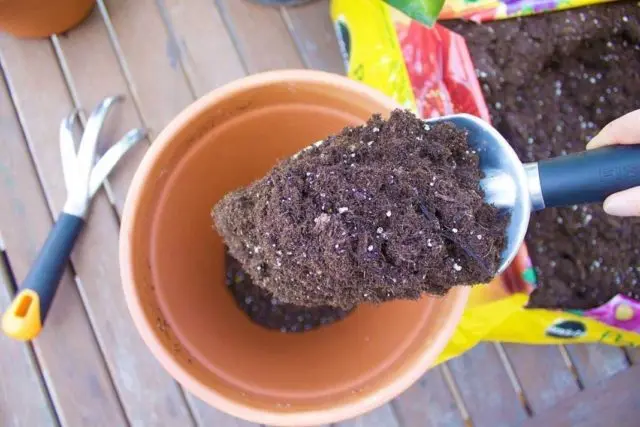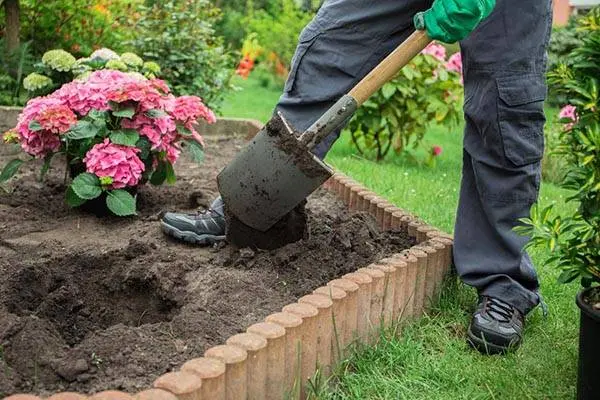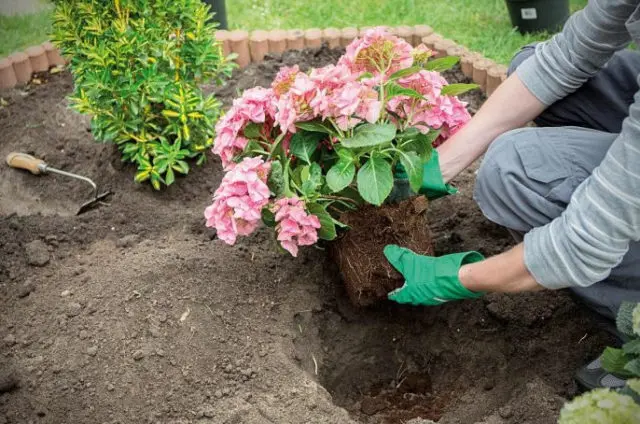Contents
The care necessary for the full development of ornamental plants is a complex process. The selection and replacement of soil is one of the most important procedures. The soil for hydrangea includes several components. The composition directly depends on the type of plant and the place where it is grown.
What kind of soil is needed for hydrangea
Hydrangea is considered an unpretentious plant to care for. But in order for it to grow normally, bloom regularly and not be exposed to diseases, attention should be paid to the composition of the soil in which it is planted.
Land for such a plant must have the following properties:
- contain a sufficient amount of nutrients;
- be loose and light;
- pass liquid well and do not retain moisture;
- do not contain larvae of harmful insects, weed seeds;
- have the right level of acidity.
Nutrients are necessary so that the plant does not experience a pronounced need for elements that it cannot obtain from sunlight. This is especially true for hydrangeas grown outdoors. In gardens and flower beds, planting is usually carried out after other plants. They absorb nutrients from the soil, so recharge is necessary.

The hydrangea got its name for its moisture-loving nature.
Looseness is another important soil requirement for hydrangeas. Their root system is sensitive to negative factors. The high density of the soil will lead to the fact that the plant will not be able to fully take root.
An equally important criterion is water permeability. The composition of the soil should provide a full outflow of fluid. Stagnation of water with abundant watering will provoke the process of decay in the root system. This is fraught with the development of diseases and the death of hydrangeas.
The flower loves soil with low or medium acidity. The pH of 5,5 is considered the optimal indicator. At the same time, lime should not be added to the composition of the soil for hydrangeas. Special procedures are carried out only if there are signs indicating a sharp drop in acidity.
The composition of the land for hydrangea
Soil requirements differ depending on where the plant is grown. For flowers kept in open areas, the requirements for soil composition are more specific. Indoor hydrangeas are less susceptible to negative factors. They are easier to adapt to indoor conditions. Therefore, the need for certain components is less pronounced.
Soil for room hydrangea
Ready-made substrate can be purchased at garden supply stores. This option is recommended for inexperienced flower growers, as it allows you to eliminate errors in the manufacture of the soil mixture with your own hands. To make the soil for hydrangea yourself, you need to know the exact composition.
You need:
- peat;
- sod and leaf land;
- sand.
The ratio of components is determined based on the size and age of the bush. Leave a drainage layer at the bottom of the pot. It is necessary to ensure the outflow of fluid and prevent stagnant processes.
The finished soil mixture must be sterilized by heat treatment. The need for such a procedure is explained by the fact that harmful microorganisms or small insect pests can get into the substrate in a place with the ground. They can not only infect hydrangeas, but also spread to other houseplants, causing disease.

Hydrangea can be grown as a garden type or on a windowsill as a houseplant
At home, the easiest way to sterilize the soil in the oven. It is enough to expose the soil to thermal effects at a temperature of +80 degrees for 1 hour.
You can shorten the duration of the process. The oven is heated to 200 degrees, put the soil mixture there for 10 minutes. Thanks to heat treatment, any pathogenic microorganisms die along with weed seeds that may have entered the ground. The disadvantage of this method is that, along with harmful bacteria, substances valuable to the plant are also destroyed.
What land is needed for hydrangea in the garden
Ordinary soil for such a plant is not suitable. One of the main reasons is the content of a large amount of organic substances. An additional factor is regular watering with hard water, which is not suitable for many ornamental plants.
The composition of the soil for garden hydrangea includes:
- fresh black soil;
- sod land;
- peat crumb;
- leafy humus;
- sand.
The described components are mixed in equal proportions. Separate holes are prepared for each plant. The depth varies depending on the size of the seedling. The bottom of the hole is covered with a drainage layer.

The flower loves light, warmth and a special substrate.
When planting in open ground, it is necessary to take into account the features of the site. Even if the land for garden hydrangea is prepared correctly, a number of factors can affect the quality of development or cause the bush to die.
Bushes should be well lit by the sun. Therefore, planting them in dark places is prohibited. The lack of light leads to a shortening of the flowering period. Also, the landing site should be protected from strong winds.
How to prepare the soil for hydrangea
There are several rules that should be followed when planting a plant in the ground. The general procedure for hydrangeas is not much different from other flowers.
The main stages of preparation:
- Digging up the earth at the landing site.
- Application of mineral fertilizers.
- Making a soil mixture with the addition of sand and peat.
- The introduction of substances to maintain the nutritional value of the soil.
For planting hydrangeas, holes are dug in advance, 35-40 cm deep. Inside the pit, it is necessary to pour the prepared soil, water it thoroughly and leave it for several days. Before planting hydrangeas, it is necessary to determine the degree of acidity. To do this, use a special apparatus or apply indicator tests.
Acidity should not exceed 6,0 pH. Otherwise, hydrangea leaves will turn yellow. At the same time, low acidity will cause the flowers to fade, and the plant itself will develop very slowly. Therefore, the recommended acidity is 5-5,5 pH.
After planting seedlings, it is necessary to mulch the soil. This contributes to better hydration of the hydrangea and the preservation of nutrients. For mulching, use compost, foliage of coniferous plants or peat chips.

The plant can be planted in May and September, subject to warm weather and lack of rain.
Planting in open ground is recommended in late spring. In May, the plant is planted at the onset of persistent warm weather, provided there is no heavy rain. Also, the procedure can be carried out in September. However, this option is relevant only for regions with a warm climate and a late onset of frost.
General recommendations for planting garden hydrangeas:
Tips from experienced gardeners
A number of recommendations will help grow beautiful hydrangeas indoors or in open areas. In addition to proper soil preparation and planting flowers, it is necessary to carry out comprehensive and thorough care.
Hydrangeas need periodic transplantation. The urgent need for such a procedure arises if an unsuitable place for growing is chosen. Regular transplantation is also required for indoor hydrangeas. The root system develops rapidly and it becomes cramped in a pot. Transplantation is best done in the fall, so that the bush has time to adapt to a new place before the cold weather.

Hydrangea should be watered no more than 1 time per week so that the water does not stagnate in the soil.
Another important recommendation is compliance with the irrigation regime. Hydrangea needs a lot of liquid. At the same time, the flower grows well only on the condition that water does not stagnate in the soil. Therefore, regular watering is necessary – once a week. At the same time, it is important to ensure that after the procedure the water is quickly absorbed by the soil, and does not stand near the roots. If the liquid does not drain in a short period of time, this indicates that the soil has become very compacted.
Experienced flower growers recommend covering garden hydrangea for the winter. Autumn pruning is preliminarily performed, during which dry and damaged shoots are removed. Fallen leaves are collected from under the bush. Otherwise, they begin to rot in the soil, causing fluid stagnation and creating conditions for the appearance of pests.
It is recommended to cover the bush with plastic wrap. It has good thermal insulation properties and at the same time sunlight is transmitted. The soil around the bush should be covered with straw, coniferous foliage or sawdust, which do not retain moisture and protect the flower from low temperatures.
Before wintering, top dressing is applied to the ground. Mineral fertilizers are useful for hydrangeas. Organic fertilization is best done in the spring, after the soil has warmed up. This contributes to the formation of buds and subsequent abundant flowering.
Conclusion
The soil for hydrangea must meet several criteria, otherwise the plant will develop poorly and often get sick. The substrate for planting such flowers can be purchased in stores or made independently. The soil mixture must necessarily include peat, sand, earth and be supplemented with minerals. In addition to proper soil preparation, such a plant needs comprehensive care, including transplanting, regular watering and shelter for the winter.









